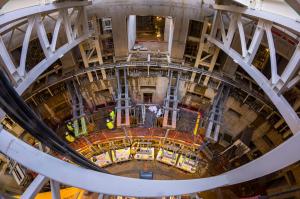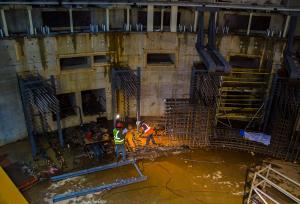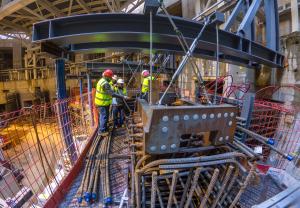Radial walls
Thickest rebar and most intricate geometry
15 Jan 2018
The combined mass of the ITER Tokamak and its enveloping cryostat is equivalent to that of three Eiffel Towers. But not only is it heavy (23,000 tonnes) ... it is also "alive." In the course of operation the machine will jump and bounce (slightly), wobble, shrink, and expand—all the while transferring considerable force to the Tokamak Building basemat and bioshield wall.
In the cavernous space of the lower Pit, workers are implementing processes and methods that have been validated on the real-size mockup. The grey structures with orange and yellow marking are temporary supports for the massive steel transition pieces.
In order to allow for the smooth transfer of these forces, the Tokamak support system will need to be extremely robust, with a strong connection to the building's structure, and yet also allow for a certain freedom of translation and rotation for the cryostat.
Connection and stability will be achieved by way of a massive pedestal—a concrete "crown" connected to walls that are radially anchored in the bioshield. Eighteen radial walls will act as the flying buttresses of a gothic cathedral, evenly distributing loads and effort.
Movement will be permitted thanks to a circular arrangement of 18 spherical bearings, acting like ball-and-socket joints that will transfer the horizontal and rotational forces generated by the tokamak.
The densest, thickest and most intricate rebar arrangements of the entire installation will be required for the crown and radial walls—to the point that it was necessary to build a full-size mockup, reproducing a 20-degree section of the structure, in order to demonstrate its full constructability.
One of the most strategic parts of ITER construction, the crown and radial walls necessitate the densest, thickest and most intricate rebar arrangements of the entire installation. The structure should be finalized by the end of the summer.
As procedures are successively validated on the mockup, they are implemented on the actual construction underway on the floor of the Tokamak Pit.
Since the temporary "lid" split the Pit in two in August, the area has been transformed from an open arena to a cavernous place, resounding with the clanging of metal and the warning signals of the circular crane and aerial work platforms.
Workers are busy installing the steel reinforcement for each radial wall: thick rebar (up to 50 millimetres in diameter) arranged in a complex geometry, and massive steel transition pieces (three tonnes each) that will transfer and distribute the loads to the concrete civil work.
From both a structural and safety perspective, the crown and its radial walls are one of the most strategic parts of the ITER installation. They should be finalized by the end of the summer.
There is one 3-tonne steel transition piece per radial wall. Their function is to transfer and distribute the loads to the building structure.




